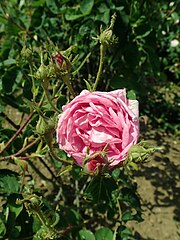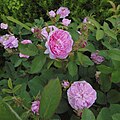Rosa centifolia
| Rosa × centifolia L. | |
|---|---|

Rosa × centifolia L. ( Rosarium Sangerhausen ) |
|
| group | Centifolia |
| known since | before 1600 |
| List of rose varieties | |
Rosa × centifolia (Latin: centifolia = "hundred-leaved"), also centifolia , is a group of roses with double flowers that is one of the old roses .
history
Theophrast and Pliny already mentioned a rosa centifolia , which is why it was previously believed that it existed in northern Greece or Asia Minor in ancient times and that it was the oldest of all roses. In contrast to the baroque or modern Rosa centifolia , however, Pliny described his hundred-petalled rose as odorless.
Today it is believed that the Rosa × centifolia was probably only developed through breeding in Holland towards the end of the 16th century . Clusius reported in his Rariorum Plantarum Historia in 1601 that he had received two plants of the alleged pink centifolia of Pliny in 1589 and described them as 'Rosa centifolia batavica' ("Dutch centifolia"). Jean Bauhin saw such a rose in Pforzheim in July 1595 , which supposedly came from Delphi in Greece and was said to have been incredibly expensive. Shortly thereafter, the English botanist John Gerard mentioned a centifolia in his catalog (1596) and described it in his Herball of 1597 as 'Rosa Hollandica sive Batava' ("Dutch or Batavian rose").
Centifolia has been depicted particularly frequently by Flemish and Dutch painters in still lifes and other paintings since around 1600 , which is why they are also known as the “ Rose des Peintres ” (French: “Rose of the Painter”) (see below). Jacques de Gheyn II created what is probably the earliest image of a centifolia in 1603.
properties

Genetic studies have shown that it is likely a cross between Rosa gallica , Rosa moschata , Rosa canina and Rosa × damascena . The growth of Rosa × centifolia is comparable to that of the wild rose Rosa gallica , strongly prickly bushes up to 2 m high, its flowers are lush, in groups, overhanging and very double - according to the name "centifolia" (hundred leaved). The color is mostly pink, but there are also white and purple tones.
The centifolia is very popular in cottage gardens , is hardy and has a lovely scent. Its petals are used to extract rose oil and rose water , for cosmetic purposes and perfume, as well as for the preparation of rose jam .
The moss roses are a subgroup of the centifolia . Most of the moss rose varieties were bred until around 1850.
sorts
The oldest known rose of this genus is the Rosa × centifolia L. , also known as the 'cabbage rose' or 'Provence rose'. Of the more than 200 centifolia that were known in the 17th and 18th centuries, around 20 types of centifolia are still on the market today. The variety 'Reine des Centifeulles', Belgium 1824, is a remarkable rose as the “Queen of the Centifolia” with a typical, fine fragrance and large, densely filled pink flowers in June. A selection of popular varieties at a glance:
- 'Blanchefleur', Vibert 1835, creamy white with a fine red border;
- 'Bullata', probably 1801, pink;
- 'Centifolia' (also 'Kohlrose', 'Provence-Rose', 'Rose des Peintres'), before 1600, very lush, pink;
- 'Centifolia variegata' (also 'Belle des Jardins', 'Cottage Maid' and others), Vibert 1845, white with pink stripes;
- 'Fantin Latour', 19th century, pink, strongly scented;
- 'Juno', 1832, pale pink;
- 'Parvifolia', 1664, purple-pink;
- 'Petite de Hollande', around 1800, miniature rose, pink;
- 'Reine des Centifeuilles', Belgium 1824, pure pink;
- 'Rose de Meaux', before 1789, miniature rose, pink;
- 'Rose de Meaux White', white - a sport of the 'Rose de Meaux';
- 'Spong', around 1805, miniature rose, pink, slightly scented;
- 'Unique Blanche', 1775, white;
Centifolia in art
Roelant Savery (1576–1639): flower vase with roses (1611)
Jan Brueghel the Elder Ä. (1568–1625): flower vase
Jan Davidsz. de Heem (1606–1684): Still life with fruits and roses (1652)
Nicolaes van Verendael (1640–1691): Still life with roses
Rachel Ruysch (1664–1750): Still life with roses (1723)
Still life by Gerard van Spaendonck (1746–1822)
literature
- Theophrastus: Historia Plantarum , Book VI, Chapter VI, Bilingual Edition by Sir Arthur Hort, 1916, Vol. 2 page 38
- Hermann Christ : On the history of the garden. In: Basler Zeitschrift für Geschichte und Altertumskunde , Vol. 17, 1918, pp. 377–385. ( Digitized version )
- Johann Daniel Denso, translation by Pliny: Naturalis historia (approx. 77 AD), 1765, Volume 2, page 224
- David Austin: Old Roses and English Roses , Dumont, Cologne 1993
- Heinrich Schultheis: Roses: the best types and varieties for the garden. Ulmer Verlag, Stuttgart 1996, ISBN 3-8001-6601-1
- Heinrich Schultheis, Helga & Klaus Urban: Rose Lexicon. 2nd edition 2001, ISBN 3-932045-25-4 (CD-ROM)
- Peter Beales: Classic roses. 2nd edition 2002, ISBN 3-8320-8736-2
Web links
- Rosa centifolia , article on the website of the International Dendrology Society online (accessed February 4, 2020)
Individual evidence
- ↑ Theophrastus: Historia Plantarum , Book VI, Chapter VI, Bilingual Edition by Sir Arthur Hort, 1916, Vol. 2 page 38
- ^ Johann Daniel Denso, translation by Pliny: Naturalis historia (approx. 77 AD), 1765, Volume 2, page 224
- ^ David Austin: Alte Rosen und Englische Rosen , Dumont, Cologne 1993, p. 52
- ↑ a b c d e Rosa centifolia , article on the website of the International Dendrology Society online (English; accessed on February 4, 2020)
- ^ David Austin: Alte Rosen und Englische Rosen , Dumont, Cologne 1993, p. 52
- ↑ Ute Bauer: Alte Rosen , page 21, Munich: BLV, 2005 ISBN 3-405-16713-2
- ↑ Dr. Hurst names Rosa phoenicea instead of Rosa damascena , but R. phoenicea is one of the ancestors of the Damascus rose. David Austin: Old Roses and English Roses , Dumont, Cologne 1993, p. 52
- ↑ Not to be confused with the name 'Provins-Rose' for Rosa gallica. David Austin: Old Roses and English Roses , Dumont, Cologne 1993, p. 24.










